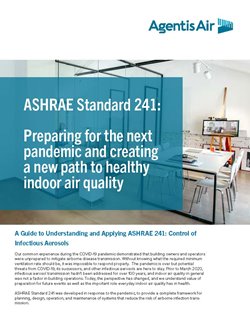
ASHRAE Standard 241: Preparing for the next pandemic and creating a new path to healthy indoor air quality

A Guide to Understanding and Applying ASHRAE 241: Control of Infectious Aerosols
Our common experience during the COVID-19 pandemic demonstrated that building owners and operators were unprepared to mitigate airborne disease transmission. Without knowing what the required minimum ventilation rate should be, it was impossible to respond properly. The pandemic is over but potential threats from COVID-19, its successors, and other infectious aerosols are here to stay.Prior to March 2020, infectious aerosol transmission hadn’t been addressed for over 100 years, and indoor air quality in general was not a factor in building operations. Today, the perspective has changed, and we understand value of preparation for future events as well as the important role everyday indoor air quality has in health.
ASHRAE Standard 241 was developed in response to the pandemic, to provide a complete framework for planning, design, operation, and maintenance of systems that reduce the risk of airborne infection transmission.
Want to learn more about how the ASHRAE Standard 241 can help you prepare? Download our free white paper now!
Get Your White Paper
By downloading this resource, I agree to sign up to receive newsletters and special offers from Facilities Management Advisor & AgentisAir. I understand that I can opt-out at any time. Privacy policy.

Sponsored by AgentisAir:
Agentis Air is on a mission to improve human health and longevity with innovative indoor air technology. With decades of university R&D experience, Agentis Air delivers high-performance solutions that are low cost-to-own, low energy, and low maintenance. Our Brio air purifier uses patented technology to improve indoor air quality exactly where you need it. A remarkable alternative to HEPA systems – Brio delivers clean air with no performance drop off, and a filter replacement rate that is 5x lower than comparable HEPA systems. Brio’s mix of high performance and low maintenance makes it ideal for use in multifamily and office locations, closing the gap between HVAC systems and truly healthy indoor air. https://agentisair.com